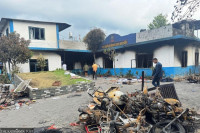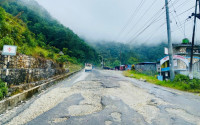Gandaki Province
Capital spending low in Myagdi local units
The local units argue that the delay in allocation of budget by the federal and provincial governments is the main reason for the low development budget expenditure.Ghanshyam Khadka
The capital expenditure for the current fiscal year 2020/21 in all local units of Myagdi district is negligible. Less than 25 percent of the development budget has been spent within the second quarter of the current fiscal year.
Annapurna Rural Municipality has spent only around 15 percent of its total capital expenditure so far. Of the total Rs 155.6 million capital expenditure, the local body has spent only Rs 23.5 million within eight months of the current fiscal year. The recurrent expenditure of the rural municipality is around 32 percent.
“The post of the chief administrative officer remained vacant for two months. As a result, the work progress and payment were hugely affected. A new executive officer has been transferred recently. The development expenditure will certainly increase in the last three months of the fiscal year,” said Jaya Prasad Subedi, the account officer of Annapurna Rural Municipality.
Meanwhile, the local units argue that the delay in allocation of budget by the federal and provincial governments is the main reason for the low budget expenditure. According to Subedi, delay in project agreement and shortage of employees are other major factors behind the minimal budget expenditure.
The situation of other local units in the district is also the same. Mangala Rural Municipality in the district had spent just 16 percent of its development expenditure by mid-March. The rural municipality completed the construction of a 10-bed hospital and a building of Mangala Secondary School with the budget. However, it spent 41 percent amounts under the recurrent budget.
Manohar Dhungana, the chief administrative officer of Mangala Rural Municipality, attributed the low capital expenditure to a shortage of employees.
“All five wards are without a secretary for months. This has affected project implementation,” he said. Dhungana claimed that work on 130 of the total 135 development projects is underway.
According to him, works on five development projects in various places have been disrupted due to disputes between the local people and the consumers’ committees. Subedi claimed that the capital expenditure will increase significantly in the last three months of the current fiscal year.
The capital expenditure of Malika Rural Municipality, Raghuganga Rural Municipality and Dhawalagiri Rural Municipality is around 22, 23 and 24 percent respectively.
According to Gopal Sharma, the chief executive officer of Dhawalagiri Rural Municipality, the project agreement of 87 development projects was signed in the current fiscal year.
“As many as 81 projects have been completed so far. The development expenditure seems low, as the last payment of those projects is not issued due to some technical problems,” said Sharma. He further claimed that natural disasters were another cause behind the low capital expenditure.
“Works on some development projects selected by the rural municipality have been affected, as the local body had to spend a large amount of budget in rescue, relief and rehabilitation of people affected by the natural disasters,” he said.
The capital expenditure rate is slightly high in Beni Municipality. According to account officer Ratna KC, the capital expenditure is 35.91 percent within the second quarter of the current fiscal year. The recurrent expenditure of the municipality is 51.18 percent.




 16.57°C Kathmandu
16.57°C Kathmandu.jpg)










